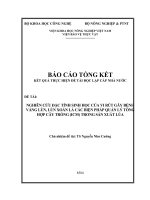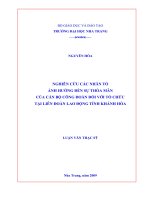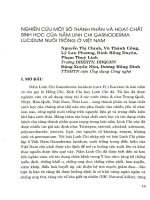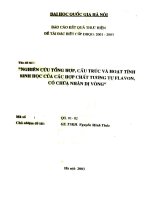NGHIÊN CỨU ĐẶC ĐIỂM HÌNH THÁI VÀ ĐẶC ĐIỂM SINH HỌC CỦA LOÀI BỌ RÙA THIÊN ĐỊCHOENOPIA KIRBYI (COLEOPTERA: COCCINELLIDAE) TẠI ĐÀ LẠT, LÂM ĐỒNG, VIỆT NAM
Bạn đang xem bản rút gọn của tài liệu. Xem và tải ngay bản đầy đủ của tài liệu tại đây (315.92 KB, 9 trang )
<span class='text_page_counter'>(1)</span><div class='page_container' data-page=1>
<b>STUDY ON MORPHOLOGICAL AND BIOLOGICAL </b>
<b>CHARACTERISTICS OF OENOPIA KIRBYI (COLEOPTERA: </b>
<b>COCCINELLIDAE) IN DA LAT CITY, LAM DONG, VIETNAM </b>
<b>Nguyen Thanh Thuy Tiena*<sub>, Nguyen Duc Sang</sub>a<sub>, Le Thi Thanh Thuy</sub>a<sub>, </sub></b>
<b>Nguyen Thi Thu Huea<sub>, Nguyen Thi Thuy Ngan</sub>a<sub>, Tran Thi Thu Dan</sub>a</b>
<i>a<sub>The Faculty of Biology, Dalat University, Lam Dong, Vietnam </sub></i>
<i>*<sub>Corresponding author: Email: </sub></i>
<b>Article history </b>
Received: June 24th<sub>, 2020 </sub>
Received in revised form: September 17th<sub>, 2020 | Accepted: October 14</sub>th<sub>, 2020 </sub>
Available online: February 5th<sub>, 2021 </sub>
<b>Abstract </b>
<i>Ladybirds are natural enemies of many agricultural crop pests, such as aphids, scale insects, </i>
<i>mealybugs, whiteflies, and thrips. This paper focuses on the morphological and biological </i>
<i>characteristics of Oenopia kirbyi (Coleoptera: Coccinellidae) in Da Lat city (Lam Dong </i>
<i>province). Field-collected adults of Oenopia kirbyi were reared in plastic boxes under </i>
<i>laboratory conditions and fed on aphids. The egg phase lasted 4.45 ± 0.71 days; the four </i>
<i>larval stages lasted 2.63 ± 0.52 days, 1.91 ± 0.73 days, 1.70 ± 0.46 days, and 5.78 ± 0.95 </i>
<i>days, respectively; and pupae lasted 7.02 ± 0.91 days. The total duration of the immature </i>
<i>stages was 23.49 days. The adult longevity of males and females was 67.13 ± 18.77 days and </i>
<i>82.83 ± 20.25 days, respectively. The fecundity was 414.00 ± 131.33 eggs on average. The </i>
<i>rate of hatched eggs, emerged adults, and the female/male ratio were 80.85%, 96.53%, and </i>
<i>1.78, respectively. These results provide basic data for rearing Oenopia kirbyi for use as a </i>
<i>biological control of crop pests. </i>
<i><b>Keywords: Biological characteristics; Morphological characteristics; Oenopia kirbyi; </b></i>
<b>Predatory ladybird. </b>
</div>
<span class='text_page_counter'>(2)</span><div class='page_container' data-page=2>
<b>1. </b> <b>INTRODUCTION </b>
Da Lat city (Lam Dong province) is a famous vegetable and flower-growing
region of Vietnam. With a cool temperate climate, Da Lat city is very suitable for the
production of vegetables and flowers all year round. This fact has allowed pests such as
aphids, mealybugs, scale insects, whiteflies, thrips, and others to thrive.
Currently, the local people mainly use chemical pesticides to control crop pests.
This has affected the health of humans and domestic animals and caused environmental
pollution. It has also caused resistance in pests and decreased the population of their
natural enemies.
Biological control is increasingly used in the integrated pest management
programs of many countries around the world and has obtained significant results
compared with chemical pesticides.
Ladybird beetles (Coleoptera: Coccinellidae) comprise 6,000 described species
worldwide, of which 90% are considered natural predators. This is one of the natural
enemy groups that play an important role in agricultural production. Their food includes
aphids, mealybugs, scale insects, whiteflies, thrips, insect eggs, small larvae, and
phytophagous mites (Ajar & Akhtar, 2017).
The number of ladybird beetle species in the fauna of Vietnam has been
discovered to be over 220 species, belonging to 65 genera, 15 tribes, and 6 subfamilies.
The number of known beneficial ladybird species in the Vietnam coccinellid fauna has
reached 165 species, belonging to 5 subfamilies and 60 genera (Hoàng, 1982). Some
studies on the biological characteristics of predatory ladybird beetles have been published
<i>for Chirocorus politus (Nguyễn & Trần, 2010), Coccinella tranversalis (Mai et al., 2005), </i>
<i>Stethorus sp., and Harmonia sedecimnotata (Nguyễn et al., 2005). </i>
During surveying and collecting of predatory ladybird beetle species in Da Lat
<i>city, we recorded that Oenopia kirbyi commonly appeared on aphid-infected plants and </i>
weeds, but until now there have been almost no detailed studies on this species. With the
hope of contributing to research on the use of predatory ladybird beetles in pest control,
<i>we studied the morphological and biological characteristics of Oenopia kirbyi in Da Lat city. </i>
<b>2. </b> <b>MATERIALS AND METHODS </b>
</div>
<span class='text_page_counter'>(3)</span><div class='page_container' data-page=3>
<i>and Tran Thi Thu Dan </i>
<i>Freshly laid eggs of Oenopia kirbyi were collected on the same day and put in a </i>
separate box. When the eggs hatched, individuals from the first instar were kept in
4 x 6 cm plastic cups covered with a perforated plastic cap and fed on aphids. New food
was provided daily. Photographs were taken, and the developmental stages and size of
the ladybirds were recorded.
<i>Photographs of the development stages of Oenopia kirbyi were taken under a </i>
stereoscopic microscope or magnifying glass. At each stage, the length and breadth of 20
individuals were measured using a stereoscopic microscope fitted with a measuring tool
(for egg and larval stages) or using a caliper (for pupal and adult stages). The colors and
morphological characteristics of the stages were observed and described.
When the adults emerged from pupae, males and females were differentiated and
<i>paired. Thirty adult pairs of O. kirbyi were reared individually in 4 x 6 cm plastic cups </i>
covered with a perforated plastic cap and fed on aphids. Eggs were collected daily, and
the number of eggs laid by each female was recorded.
Experiments were conducted at a temperature of 21 ± 2 °C and relative humidity
of 80 ± 5%.
The data were statistically processed using Microsoft Excel software. Means (X)
were calculated using the AVERAGE function, and standard deviations (SD) were
calculated using the STDEV function.
<b>3. </b> <b>RESULTS </b>
<b>3.1. Morphological characteristics </b>
<i>The ladybirds Oenopia kirbyi are holometabolous insects, undergoing a complete </i>
metamorphosis with four discrete life stages: egg, larva, pupa, and adult beetle.
<i>3.1.1. Egg stage </i>
</div>
<span class='text_page_counter'>(4)</span><div class='page_container' data-page=4>
(a) (b)
(c) (d)
(e) (f)
</div>
<span class='text_page_counter'>(5)</span><div class='page_container' data-page=5>
<i>and Tran Thi Thu Dan </i>
<i>3.1.2. Larval stage </i>
<i>Larvae of O. kirbyi are elongate, tapering posteriorly. The body is divided into </i>
three parts: head, thorax, and abdomen. There are four instars in larval life with three
molts.
Larvae newly hatched from eggs are called first instar larvae. They are dark gray,
covered with many small hairs, and have no distinctive color or pattern (Figure 1c). The
first instar and second instar larvae are quite similar in shape. They only differ in size, with
average sizes of 2.16 ± 0.04 mm x 0.74 ± 0.01 mm and 2.77 ± 0.03 mm x 0.78 ± 0.02 mm
<i>for first and second instar larvae, respectively (n = 20). </i>
The third instar larvae have ivory-white and orange-yellow blotches on the thorax
and abdomen. The blotches on the abdomen are arranged in a T-shape (Figure 1d). Third
<i>instars have an average size of 3.51 ± 0.04 mm x 1.11 ± 0.03 mm (n = 20). </i>
The fourth instar larvae are not much changed in morphology compared to the
third instar larvae, but they have grown significantly in size. Their average size is
<i>5.16 ± 0.04 mm x 1.46 ± 0.03 mm (n = 20). The older larvae have orange-yellow blotches </i>
that turn darker and darker (Figure 1e).
The fully grown fourth instar larvae turn into the pre-pupal stage. At this stage,
they cease to feed and become inactive. They attach themselves to the substrate in the box
using their anal pad and their bodies shrink (Figure 1f).
<i>3.1.3. Pupal stage </i>
Pupae are initially orange-yellow in color with patterns similar to those of fourth
instar larvae, then they darken (Figure 1g). The average pupal size is 3.50 ± 0.17 mm x
<i>2.33 ± 0.18 mm (n = 20). </i>
<i>3.1.4. Adult stage </i>
Adult beetles are oval, convex, and glabrous. Both male and female adults have
black heads. The male beetles are recognised with a white forhead (Figure 1j). The elytra
are pale yellow with a black margin and two black spots in each elytron. The lateral edge
is uniformly black. The black strip along the meeting line of both elytra is irregular,
bulging in the center (Figure 1i and 1j). The mean sizes of male and female adults are
<i>3.37 ± 0.13 mm x 2.65 ± 0.16 mm and 3.95 ± 0.14 mm x 2.94 ± 0.17 mm (n = 20), </i>
respectively.
</div>
<span class='text_page_counter'>(6)</span><div class='page_container' data-page=6>
<b>3.2. Biological characteristics </b>
<i>3.2.1. Duration of immature stages </i>
The immature development period consists of three stages: egg, larva, and pupa.
The egg incubation period was 3-6 days, with an average of 4.45 ± 0.71 days
(Table 1). The group with the 4-day duration accounted for the highest percentage
(58.19%), and the group with the duration of 3 days had the lowest percentage (3.14%).
The newly hatched larvae did not move immediately but usually remained
stationary for several hours to half a day. Their first meal was their eggshells and the
unhatched eggs. Then they began to move freely in search of food.
The first instar larvae lasted from 2-4 days, with a mean duration of 2.63 ± 0.52
days (Table 1). The group with a 3-day duration accounted for the most individuals
(59.09%). The group with a duration of 4 days had the fewest individuals (1.71%).
The duration of the second and third instars was quite short, only 1-3 days, with
an average of 1.91 ± 0.73 days for the second instars and 1.70 ± 0.46 days for the third
instars (Table 1). The group with the 2-day duration accounted for the highest percentage
of both instars, with 46.39% for the second instars and 69.54% for the third instars,
respectively.
<b>Table 1. Duration of immature stages of Oenopia kirbyi </b>
Developmental stage Number of observed individuals
<i> (n) </i>
Duration (days)
(X ± SD)
Egg 287 4.45 ± 0.71
First instar 176 2.63 ± 0.52
Second instar 166 1.91 ± 0.73
Third instar 151 1.70 ± 0.46
Fourth instar 144 5.78 ± 0.95
Pupa 139 7.02 ± 0.91
Immature development period 23.49
</div>
<span class='text_page_counter'>(7)</span><div class='page_container' data-page=7>
<i>and Tran Thi Thu Dan </i>
<i><b>Figure 2. Duration of the immature stages of Oenopia kirbyi </b></i>
The duration of the pupae lasted from 6-11 days, averaging 7.02 ± 0.91 days
(Table 1). The group with the 7-day duration accounted for the highest percentage of
individuals (55.40%).
<i>In general, the duration of the egg, larval, and pupal stages of Oenopia kirbyi was </i>
<i>slightly different from that of other predatory ladybirds. In Coccinella tranversalis, the </i>
average egg period was 3.86 days, the larval stage varied from 14 to 17 days, and the
pupal period was 5.05 days (Mai et al., 2005). The average incubation period of
<i>Chilocorus politus was recorded by Nguyễn and Trần (2010) to be 3.7 days. The larval </i>
stages (from first to fourth) were 1.9, 1.8, 2.2, and 3.9 days, respectively. The pupal period
was 7.1 days (Nguyễn & Trần, 2010).
<i>3.2.2. Duration of adult stage </i>
<i>Adult longevity of Oenopia kirbyi was significantly different among observed </i>
individuals. In general, the longevity of males was shorter than that of females. The
average longevity of males was 67.13 ± 18.77 days; the shortest was 28 days and the
longest was 103 days. The longevity of females varied from 45 to 111 days, with an
average of 82.83 ± 20.25 days (Table 2).
<b>Table 2. Duration of adult stage of Oenopia kirbyi </b>
</div>
<span class='text_page_counter'>(8)</span><div class='page_container' data-page=8>
The average pre-oviposition period and oviposition period of females was
12.50 ± 2.26 days and 65.53 ± 21.88 days, respectively (Table 2).
<i>Our results are quite similar to those of Nguyễn and Trần (2010). In Chilocorus </i>
<i>politus, there is a big difference in longevity between males and females. The average </i>
longevities of males and females were 45 days and 80.6 days, respectively (Nguyễn &
Trần, 2010).
<i>3.2.3. Fertility </i>
Usually, ladybird eggs were laid in clusters, sometimes scattered. In the
laboratory, eggs were laid mainly on covers, on bean leaves, or in the boxes. There was a
large variation in the number of eggs laid by observed individuals. The results in Table 3
<i>show that under laboratory conditions, an Oenopia kirbyi female can lay 128 to 630 eggs, </i>
with an average of 414.00 ± 131.33 eggs. According to our observations, the number of
eggs laid per female in a day was up to 22 eggs.
<i>Compared to other species, the number of eggs laid by Oenopia kirbyi is quite </i>
<i>high. The number of eggs laid per female varies among species: in Chilocorus politus the </i>
<i>average is 183.5 eggs (Nguyễn & Trần, 2010), in Coccinella tranversalis it is 177 eggs </i>
<i>(Mai et al., 2005), in Stethorus sp. it is 28.6 eggs, and in Harmonia sedecimnotata it is </i>
414.7 eggs (Nguyễn et al., 2005).
Under laboratory conditions (temperature 21 ± 2 °C, relative humidity 80 ± 5%),
the percentage of hatched eggs was 80.85%. The percentage of adults to emerge from
pupae was 96.53%, of which males accounted for 35.97% and females 64.03%. The
female/male ratio was 1.78. (Table 3). This result indicates the potential for rearing
<i>Oenopia kirbyi to control aphids and other crop pests in Da Lat city (Lam Dong province). </i>
<b>Table 3. Fertility of Oenopia kirbyi </b>
Criteria Mean (X ± SD)
Fecundity (eggs/female) 414.00 ± 131.33
<i>(n = 30) </i>
Rate of hatched eggs (%) 80.85
<i>(n = 355) </i>
Rate of emerged adults (%) 96.53
</div>
<span class='text_page_counter'>(9)</span><div class='page_container' data-page=9>
<i>and Tran Thi Thu Dan </i>
<b>4. </b> <b>CONCLUSIONS </b>
<i>The average incubation period of Oenopia kirbyi was 4.45 ± 0.71 days. Mean </i>
duration of larval stages (from firstto fourth) were 2.63 ± 0.52 days, 1.91 ± 0.73 days,
1.70 ± 0.46 days, and 5.78 ± 0.95 days, respectively. The pupal period was 7.02 ± 0.91
days. In general, the total period of the immature stages was 23.49 days.
The average longevity of adult males was 67.13 ± 18.77 days, and that of adult
females was 82.83 ± 20.25 days.
The average number of eggs laid per female was 414.00 ± 131.33 eggs.
The rate of hatched eggs, rate of emerged adults, and female/male ratio were
80.85%, 96.53%, and 1.78%, respectively.
<b>REFERENCES </b>
Ajar, A. K., & Akhtar, A. K. (2017). Coccinellids as biological control agents of soft
<i>bodied insects: A review. Journal of Entomology and Zoology Studies, 5(5), </i>
1362-1373.
<i>Hoàng, Đ. N. (1982). Bọ rùa–Coccinellidae ở Việt Nam. NXB Khoa học và kỹ thuật. </i>
Mai, P. Q., Vũ, T. C., & Nguyễn, T. M. (2005). Một số đặc điểm sinh học của bọ rùa
<i>chữ nhân Coccilnella transversalis Fabricius (Coleoptera: Coccinellidae). In Q. </i>
<i>C. Vũ (Ed.), Báo cáo khoa học Hội nghị cơn trùng học tồn quốc lần thứ 5 (pp. </i>
181-183). NXB Nông nghiệp.
<i>Nguyễn, T. T. C., & Trần, N. T. T. (2010). Đặc điểm sinh vật học của bọ rùa Chilocorus </i>
<i>politus Mulsant (Coleoptera: Coccinellidae). Tạp chí khoa học Trường Đại học </i>
<i>Cần Thơ, 14, 66-75. </i>
Nguyễn, T. V., Phạm, V. L., Nguyễn, T. K. H., & Trương, T. L. (2005). Đặc điểm sinh
<i>vật học của bọ rùa đen nhỏ Stethorus sp. và bọ rùa 17 chấm Harmonia </i>
</div>
<!--links-->









